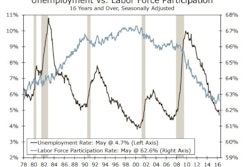The labor market report for June is a refreshing tonic after last month’s discomfort.
The Bureau of Labor Statistics (BLS) reported payroll employment growth rebounded in June, expanding by 287,000 after an unnervingly weak May. Gains in the information sector were boosted by the return of roughly 40,000 Verizon workers who had been out on strike in May. But even without that one off gain, the June advance brings payroll growth back in line with the earlier strong trend (raising the three-month average to 147,000 new jobs per month). April and May payroll gains were revised downward by a net 6,000.
The unemployment rate rose to 4.9% driven by a large increase in the labor force (414,000), partially reversing the sharp decline in May, to 4.7% from 5.0% in April, which was driven by a large decline in the labor force (458,000). Hovering near 5%, the unemployment rate is now in a range most economists consider normal. In the dynamic US economy 95% of the labor force is employed with only 5% between jobs or displaced.
With this tightening in the labor market average hourly earnings have been trending upward since early 2015 as the unemployment rate approached 5%. Average hourly earnings were up 2.6% over the 12 months ending in June. At this point in the labor market recovery wage gains, gains in the labor force and declines in the number of involuntary part-time workers will be better indicators of the health of the labor market then further declines (or increases) in the unemployment rate.
The June report will be well received at the Federal Reserve where policymakers made an abrupt about-face in response to the weak May report. The minutes from the mid-June Federal Open Market Committee (FOMC) meeting identify the slowdown in May as a major concern contributing to the decision not to raise interest rates. The rebound in June will be comforting, we’ll see if it’s enough to prompt a rate hike at the upcoming July meeting (probably not).

















